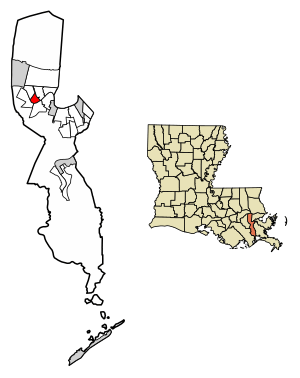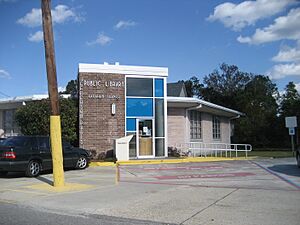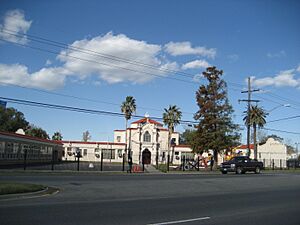Harahan, Louisiana facts for kids
Quick facts for kids
Harahan, Louisiana
|
||
|---|---|---|
| City of Harahan | ||

Welcome sign on Jefferson Highway
|
||
|
||

Location of Harahan in Jefferson Parish, Louisiana.
|
||

Location of Louisiana in the United States
|
||
| Country | ||
| State | ||
| Parish | Jefferson | |
| Area | ||
| • Total | 2.49 sq mi (6.46 km2) | |
| • Land | 2.02 sq mi (5.23 km2) | |
| • Water | 0.48 sq mi (1.23 km2) | |
| Elevation | 10 ft (3 m) | |
| Population
(2020)
|
||
| • Total | 9,116 | |
| • Rank | JE: 3rd | |
| • Density | 4,517.34/sq mi (1,743.95/km2) | |
| Time zone | UTC-6 (CST) | |
| • Summer (DST) | UTC-5 (CDT) | |
| ZIP code |
70123
|
|
| Area code(s) | 504 | |
| FIPS code | 22-32930 | |
| GNIS feature ID | 2403796 | |
Harahan is a city in Jefferson Parish, Louisiana. It is a suburb located near the larger city of New Orleans. In 2020, about 9,116 people lived there.
Contents
History of Harahan
Harahan is built on land that was once part of a large farm called the Soniat Plantation. This area was perfect for farming and raising cattle. In the late 1800s, part of this land was used as an experimental farm by Southern University and A&M College.
How Harahan Grew
The city started to develop in 1894 when the Illinois Central Railroad (now Canadian National) built a place to fix trains and a roundhouse (a building for turning locomotives) nearby. In 1914, a company made of railroad officials bought the university's land. They divided it into smaller plots for homes. Many railroad workers, river workers, and farmers moved there.
Becoming a City
The village of Harahan officially became a city in 1920. It was named after James Theodore Harahan, who was the president of the Illinois Central Railroad.
Railroad and River Connections
Before the Huey P. Long Bridge was built, Harahan was one of the only places on the Mississippi River where trains could cross. The Illinois Central and Southern Pacific Railroads used a ferry to carry train cars across the river between Harahan and Avondale. Some of the world's largest barges, like the Mastodon, Mammoth, and El Grande, used to be based in Harahan.
Early Aviation and Parks
In 1908, the Colonial Country Club was built on the old Soniat Plantation. By 1910, an area on the eastern edge of Harahan became the main airport for New Orleans. A famous pilot named John Moisant sadly died there in a plane accident. Harahan later named Moisant Park after him, though it was renamed Zeringue Park after World War II.
Growth and Modernization
The Huey P. Long Bridge opened in 1930, which made Harahan even more important. By 1940, the population had grown to 1,082 people.
During World War II, a military camp called Camp Plauche was set up where Elmwood is today. Factories in Harahan also made important parts for airplanes and boats for the war. This led to a lot of new homes and jobs, and Harahan's population tripled during this time. This growth continued after the war.
By 1960, over 9,000 people lived in Harahan. The city improved its police and fire departments, paved more streets, and built a water treatment plant. The Earhart Expressway was completed, making it easier to get to New Orleans. This made Harahan a popular "bedroom community" where people lived but worked in the bigger city.
Population and People
| Historical population | |||
|---|---|---|---|
| Census | Pop. | %± | |
| 1930 | 892 | — | |
| 1940 | 1,082 | 21.3% | |
| 1950 | 3,394 | 213.7% | |
| 1960 | 9,275 | 173.3% | |
| 1970 | 13,037 | 40.6% | |
| 1980 | 11,384 | −12.7% | |
| 1990 | 9,927 | −12.8% | |
| 2000 | 9,885 | −0.4% | |
| 2010 | 9,277 | −6.2% | |
| 2020 | 9,116 | −1.7% | |
| U.S. Decennial Census | |||
Population Changes Over Time
The 2010 U.S. census counted 9,277 people living in Harahan. By the 2020 United States census, the population was 9,116.
In 2000, there were 9,885 people. Most households (55.2%) were married couples living together. About 28.2% of households had children under 18. The average household had 2.42 people.
Who Lives in Harahan?
In 2000, about 20.8% of the people were under 18 years old. About 19.8% were 65 or older. The average age was 41 years.
In 2019, the average age was 44.2 years. Most people (90.9%) spoke only English at home.
Income in Harahan
In 2019, the average income for a household in Harahan was about $66,741 per year. This was higher than the $44,702 average income in 2000. About 10.3% of the city's population lived in poverty in 2019.
Diversity in Harahan
In 2019, most people in Harahan (83.9%) were non-Hispanic white. About 4.8% were Black or African American, and 1.1% were Asian. About 10% of the population was Hispanic or Latino American.
A year later, in 2020, the numbers were similar. Harahan has remained mostly non-Hispanic white, even as other groups have moved to different suburbs around New Orleans.
| Race / Ethnicity (NH = Non-Hispanic) | Pop 2000 | Pop 2010 | Pop 2020 | % 2000 | % 2010 | % 2020 |
|---|---|---|---|---|---|---|
| White alone (NH) | 9,415 | 8,468 | 7,421 | 95.25% | 91.28% | 81.41% |
| Black or African American alone (NH) | 61 | 197 | 382 | 0.62% | 2.12% | 4.19% |
| Native American or Alaska Native alone (NH) | 43 | 42 | 17 | 0.44% | 0.45% | 0.19% |
| Asian alone (NH) | 34 | 93 | 110 | 0.34% | 1.00% | 1.21% |
| Pacific Islander alone (NH) | 3 | 3 | 1 | 0.03% | 0.03% | 0.01% |
| Other race alone (NH) | 6 | 13 | 16 | 0.06% | 0.14% | 0.18% |
| Mixed race or Multiracial (NH) | 80 | 56 | 352 | 0.81% | 0.60% | 3.86% |
| Hispanic or Latino (any race) | 243 | 405 | 817 | 2.46% | 4.37% | 8.96% |
| Total | 9,885 | 9,277 | 9,116 | 100.00% | 100.00% | 100.00% |
Arts and Culture in Harahan
The Jefferson Parish Library runs the Harahan Library, which is a great place for books and learning.
Parks and Recreation in Harahan
Harahan used to have the Colonial Golf and Country Club. This club even hosted a big golf tournament called the 1954 New Orleans Women's Open. It closed in 2012.
Education in Harahan
Public schools in Harahan are managed by the Jefferson Parish Public School System (JPPSS).
Public Schools
Students living in Harahan go to Harahan School for grades from pre-kindergarten to 8th grade. For high school, they attend Riverdale High School in nearby Jefferson.
Students who want to attend advanced studies academies are zoned to Airline Park Academy.
Other Schools
The Jefferson Parish campus of the International School of Louisiana (ISL), which is a charter school, opened near Harahan in Elmwood in 2012. Later, it moved to Metairie.
Private schools in Harahan include St. Rita, a Catholic elementary and middle school. There is also Faith Lutheran, which is a private Lutheran school for students from kindergarten to 12th grade.
Notable People from Harahan
- Robert T. Garrity, Jr., a politician
- Johnny Giavotella, a baseball player who played second base for the Kansas City Royals
See also
 In Spanish: Harahan para niños
In Spanish: Harahan para niños




